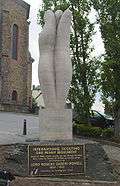Wiltz
Wiltz (Luxembourgish: Wolz, pronounced [ˈvolts]) is a commune with town status in north-western Luxembourg, capital of the canton Wiltz. Wiltz is situated on the banks of the river Wiltz. It was also a battleground in the Battle of the Bulge, near the end of World War II. A local airfield (near the village of Noertrange) was used by both sides of the conflict, depending on the location of the Front.
Wiltz Wolz (Luxembourgish) | |
|---|---|
Town hall | |
 Coat of arms | |
Map of Luxembourg with Wiltz highlighted in orange, and the canton in dark red | |
| Coordinates: 49.9667°N 5.9333°E | |
| Country | |
| Canton | Wiltz |
| Government | |
| • Mayor | Fränk Arndt (LSAP) |
| Area | |
| • Total | 39.25 km2 (15.15 sq mi) |
| Area rank | 14th of 102 |
| Highest elevation | 518 m (1,699 ft) |
| • Rank | 14th of 102 |
| Lowest elevation | 285 m (935 ft) |
| • Rank | 87th of 102 |
| Population (2018) | |
| • Total | 6,866 |
| • Rank | 20th of 102 |
| • Density | 170/km2 (450/sq mi) |
| • Density rank | 45th of 102 |
| Time zone | UTC+1 (CET) |
| • Summer (DST) | UTC+2 (CEST) |
| LAU 2 | LU0000807 |
| Website | wiltz.lu |
As of 2014, the town of Wiltz, which lies in the south of the commune, has a population of 5,469.[2].
Populated places
The commune consists of the following villages:
|
|
History
The name "Wiltz" comes from a Celtic word meaning "on the creek." Wiltz was originally inhabited by the Celts, and was first documented in 764AD. It received its town rights in 1240. The counts of Wiltz are among the oldest in Luxembourg.[3]
One of the main features of the town is Wiltz Castle which belonged to the former Counts of Wiltz. This castle, which is situated on 600 acres (2.4 km2) of lawns and gardens, contains hundreds of rooms. It was completed in 1727, and the final Count died in 1793. It served as a private girls school from 1851 until 1950, and became a retirement home after that. The industrialisation of Wiltz was advanced in the late 19th and early 20th century by the leather industry, namely by IDÉAL Tannerie de Wiltz S.A. belonging to the Adler & Oppenheimer trust.
During World War II, Luxembourg was occupied 10 May 1940 (the first day of the Battle of France). On 31 August 1942, a general strike was initiated in Wiltz, that spread throughout the country.
On 16 December 1944, the Wehrmacht surprisingly began the Ardennes Offensive. Norman Cota, the commander of the 28th Infantry Division and his staff left Wiltz when the Germans came nearer. In the evening of 19 December, after some combat, the last Americans left Wiltz.
On January 1945, Wiltz was liberated by American troops after intensive combats during the days before.[4]
Wiltz was named Martyr Town after the war. A monument representing a lighthouse was erected to commemorate the victims of the repression following the 1942 General Strike.[5]
In 2015, Wiltz absorbed the neighbouring commune of Eschweiler.[6]
Town Centre
Wiltz has a quiet town centre. There is an outdoor musical hall with bands and classical musical shows held typically every fortnight. Looking out from the hill on the music hall one will see the largest lake in the country at Esch-sur-Sure, located around 20 km away. A local multi-carriage tourist "road-train" takes visitors around the village and its surroundings on the hour.

There is also an international soccer training pitch. In the heart of Wiltz there is plenty to see with a second world war tank parked in the main plaza. One of the most popular nights out is the summer rave held 10 km in the wilderness. A local farm has been transformed into a pub and rave club, this is a favourite night out for scout units (male and female).
Attractions
Wiltz is a major centre for the international scouting movement. There are many scout campsites and buildings surrounding the town. The International Scouting One Penny Monument, dedicated to Robert Baden-Powell, is located in Wiltz.
Nearby Wiltz, on a hill overlooking the town, the Sanctuary of Our Lady of Fatima is the site of an annual pilgrimage on Ascension Day. In particular it attracts many of the Portuguese people who form a sizeable proportion of the population of Luxembourg.
The Festival of Wiltz, a music and performing arts festival, takes place every summer.
Tourism
In 2015 it was the venue for the Linuxbierwanderung.
Notable people
- Paul Wilwertz (1905–1979) a Luxembourgian politician
- Romain Schneider (born 1962) a Luxembourgian politician
- Kevin Malget (born 1991) a Luxembourgish international footballer
- Richard Brookins (1922–2018), honorary citizen, the "American St. Nick"
See also
References
- "WILTZ - Syvicol". www.syvicol.lu. Retrieved 3 April 2019.
- "Population of Wiltz, Luxembourg". wiltz.lu. Retrieved 27 May 2014.
- German Wikipedia
- Chronologie (pdf)
- The relief on the monument is by Luxembourg's best-known modern sculptor Lucien Wercollier.
- "Eschweiler and Wiltz Municipalities to Merge". 8 July 2014. Retrieved 13 June 2015.
External links
| Wikivoyage has a travel guide for Wiltz. |
| Wikimedia Commons has media related to Wiltz. |
